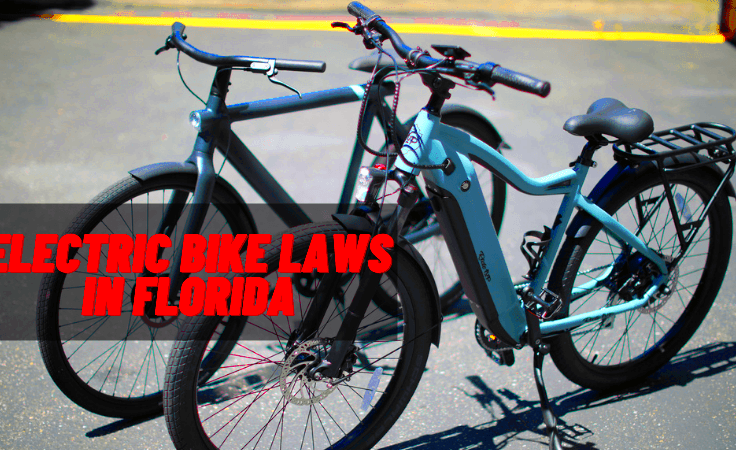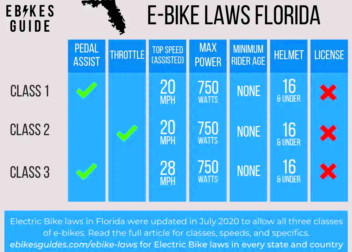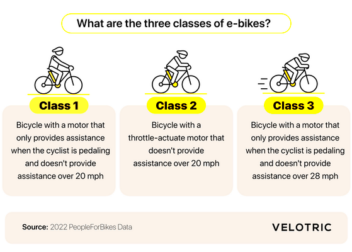Florida’s Class 3 Electric Bike Laws Explained
Electric bikes especially the Class 3 ones have become incredibly popular in Florida. As a cycling enthusiast who enjoys the extra power of an electric motor I’ve witnessed how these bikes can revolutionize everyday commutes. In Florida Class 3 electric bikes are becoming a choice due to their convenience and efficiency. Its important to be aware of the rules and regulations regarding these bikes to ensure a smooth and lawful riding experience.
Class 3 e bikes known as speed pedelecs are built for riders who require a boost in power compared to Class 1 and Class 2 models. With a motor that supports speeds of up to 28 mph they are ideal for city travel or extended journeys. However due to their speed there are regulations in place so it’s crucial to stay updated on the specific rules that govern their use.
Definition and Classification of Class 3 Electric Bikes

Class electric bikes fall into a specific category among the diverse types of e bikes available. Lets take a closer look at what sets them apart.
- Motor Assistance: The motor on a Class 3 e-bike assists up to 28 mph, significantly faster than the 20 mph limit on Class 1 and Class 2 e-bikes.
- Pedal-Assist: Unlike Class 2 bikes that can be powered solely by a throttle, Class 3 bikes require pedaling to activate the motor assistance.
- Speed: The motor only assists the rider up to 28 mph. Beyond this, the bike relies solely on the rider’s power.
From what I’ve seen riding a Class 3 bike gives you a mix of the classic cycling experience and the thrill of speed. It’s an exciting ride but it’s important to be mindful of the speed limits and safety rules that are in place.
Key Regulations for Operating Class 3 Electric Bikes
In Florida using a Class 3 electric bike involves following certain rules to prioritize safety and adherence. Here are the key points you should be aware of.
- Helmet Requirement: Riders under 16 must wear a helmet. While helmets are not mandatory for adults, it’s highly recommended for safety.
- Bike Lanes: Class 3 bikes are generally not allowed on bike paths or multi-use trails unless specifically permitted by local ordinances.
- Street Riding: They can be ridden on roads where the speed limit is 30 mph or less, and sometimes on roads with higher speed limits depending on local laws.
- Equipment: Ensure your bike has functional lights, bells, and reflective gear if required by local regulations.
Based on what I’ve seen following these rules has really enhanced my trips and made them more relaxing. Its similar to being aware of the traffic laws before hitting the road – it helps you stay ready and secure.
Age Restrictions and Helmet Requirements
When it comes to riding Class 3 electric bikes in Florida it’s crucial to be aware of the age restrictions and helmet requirements. As someone who has spent years cycling in different conditions I have come to realize the significance of these rules in ensuring road safety. It’s not merely about adhering to the law; it’s also about safeguarding yourself and those around you.
Lets take a moment to examine the rules regarding age limits and helmet usage.
- Age Restrictions: In Florida, riders of Class 3 electric bikes must be at least 16 years old. This is because the increased speed of these bikes demands a higher level of responsibility and maturity.
- Helmet Requirements: For riders under 16, wearing a helmet is mandatory. While helmets are not legally required for those over 16, wearing one is strongly advised. In my experience, a good helmet can make a significant difference in a fall or collision, and it’s always better to be safe than sorry.
I often come across kids speeding by on their bikes without any head protection and it really makes me anxious. While helmets may not be mandatory for adults I always put mine on during rides. You never know when an accident might occur. It’s a little price to pay for some reassurance.
Where Class 3 Electric Bikes Can Be Ridden
It’s essential to be aware of the areas where you can ride your Class 3 electric bike to steer clear of penalties and enjoy a seamless journey. I recall an incident when I unintentionally brought my Class 3 bike onto a trail that was off limits and it led to an rather uncomfortable situation with law enforcement. Since that incident I’ve learned to be more cautious about the places I can ride.
Here’s a rundown of where you can usually ride Class 3 e bikes.
- Roads: Class 3 bikes can be ridden on roads where the speed limit is 30 mph or less. This is ideal for urban and suburban areas where the traffic is moderate.
- Bike Lanes: In many areas, Class 3 bikes are not permitted on traditional bike lanes. Always check local regulations, as some cities may have specific allowances or restrictions.
- Multi-Use Trails: Generally, Class 3 bikes are restricted from multi-use trails unless local rules state otherwise. It’s best to stick to paved roads or designated bike paths to avoid any trouble.
I recommend taking a moment to review the regulations in your area before you go. This way you can avoid any surprises and ensure that you are riding within the boundaries of the law.
Legal Requirements for Equipment and Safety
Making sure that your Class 3 e bike complies with the legal standards for safety and equipment is essential. I’ve had my moments and ensuring that your bike meets the requirements can help avoid problems. Based on my experiences having the gear can greatly enhance the security and comfort of your ride.
Below are the key legal obligations related to equipment and safety.
- Lights: Many places require that Class 3 bikes have front and rear lights. These are essential for visibility, especially during dawn, dusk, or nighttime riding.
- Bell or Horn: A bell or horn is often required to alert pedestrians and other road users of your presence. It’s a small but important feature that can help prevent accidents.
- Reflective Gear: Some local regulations mandate reflective gear or stickers on the bike to enhance visibility. This is especially important if you ride in areas with heavy traffic.
- Brake System: Ensure your bike has a reliable braking system. Class 3 bikes are fast, and having effective brakes is crucial for safety.
From what I’ve seen putting in the effort to make sure your bike is set up properly is definitely worthwhile. It’s not only about following the rules but also about keeping yourself safe and having a good time while riding. When your bike is well taken care of it makes every journey smoother and safer.
Penalties for Non-Compliance with Florida’s Laws
It’s important for every cyclist to be aware of the consequences of not adhering to Floridas Class 3 electric bike regulations. Having personally dealt with the intricacies of the law I understand how easy it is to stumble upon rules, particularly since they can differ from place to place. Dealing with fines and penalties can be quite a hassle so it’s beneficial to be informed about what to anticipate in order to steer clear of any unexpected surprises.
If you dont follow the rules for Class 3 electric bikes in Florida you could face these potential outcomes.
- Fines: Violation of local bike laws can result in fines. For instance, riding in prohibited areas or failing to wear a helmet when required might cost you anywhere from $50 to $200, depending on the offense and location.
- Impoundment: In some cases, local authorities might impound your bike if it’s found to be non-compliant. This can be both inconvenient and costly, as you’ll not only have to pay a fine but also retrieval fees.
- Points on License: Although not common, some severe violations might lead to points on your driving license if you have one, affecting your insurance rates and driving record.
Based on what I’ve witnessed friends getting tangled up in the details of cycling regulations. A buddy of mine received a ticket for not having lights on his bike. It was an expensive wake up call for him and it made me more careful about following all the rules. Staying updated and sticking to the regulations is the way to go, to steer clear of these fines.
How to Stay Informed and Updated on Changes
Staying informed about updates to Class 3 e bike regulations is crucial for riders who wish to comply with the law. As an avid cyclist I recognize the significance of being well informed to prevent any legal complications and ensure a seamless biking experience.
Here are a few effective strategies to keep yourself informed.
- Local Government Websites: Check your city or county’s official website regularly. They often post updates on new regulations or changes to existing ones.
- Community Forums: Join local biking forums or social media groups. Fellow bikers often share news and updates about changes in laws and regulations.
- Bike Shops: Local bike shops are a great resource. They often keep up with legal changes and can provide advice on compliance.
- News Outlets: Local newspapers or news websites sometimes cover changes in biking laws, especially if there’s a significant shift or new legislation.
From what I’ve seen getting involved in a biking community has proven to be quite beneficial. The group regularly shares news and helpful advice which helps me stay in the loop. Its also an excellent opportunity to not stay updated on the rules but to meet fellow biking enthusiasts as well.
FAQ
Q: What is a Class 3 electric bike?
A Class 3 e bike is an electric bicycle that provides assistance to riders reaching speeds of up to 28 mph. Unlike Class 1 and 2 e bikes the motor of a Class 3 bike is activated through pedaling and cannot be used solely with a throttle.
Q: Are helmets mandatory for all riders of Class 3 electric bikes in Florida?
Helmets are only required for those under 16 years old. Although there is no legal obligation for adults to wear helmets it is highly advised for safety purposes.
Q: Can Class 3 electric bikes be ridden on bike paths and trails?
In most cases, Class 3 bicycles aren’t permitted on bike paths and shared trails unless there are specific local rules that allow it. To steer clear of any problems it’s a good idea to review the regulations in your area.
Q: What happens if I’m caught riding my Class 3 bike in a prohibited area?
Be aware that you might encounter penalties and in certain situations your bicycle might be confiscated. Its important to check the regulations for the area you intend to ride in.
Q: How can I find out about updates to electric bike laws?
Keep an eye on your local government websites, participate in biking communities and stay in touch with nearby bike shops to stay updated on any legal changes.
Conclusion
Exploring the realm of Class 3 e bikes in Florida is an adventure that comes with its fair share of obstacles. It’s essential to grasp the nuances of the regulations and stay updated on any changes to them. Having navigated this path as a passionate cyclist I’ve come to realize that being well informed is key. Following the rules not keeps you secure but also allows you to relish your rides without any unwelcome surprises along the way.
Whether it’s about knowing the routes you can take, the safety gear to wear or the consequences of not following the rules staying informed and compliant is essential. I recommend getting involved in the biking community staying tuned to official announcements and always putting safety first. This way you’ll have a great time riding your Class 3 electric bike while staying on the right side of the law. Enjoy your biking adventures!


